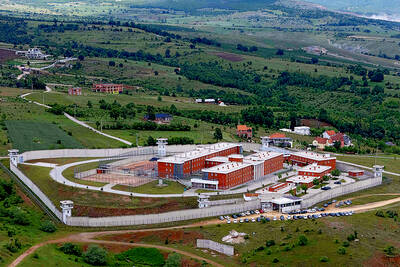China's third confirmed bird-flu death highlights the danger of small, undetected H5N1 outbreaks, the WHO said yesterday, as authorities probed how the victim fell ill.
China's health ministry announced on Thursday that a 41-year-old woman from the eastern province of Fujian had died on Dec. 21 after contracting the H5N1 virus about two weeks earlier.
However the woman, a factory worker, lived in an area where no outbreaks had been reported, repeating a pattern seen in China this year.
"We still don't know through which channel this woman was infected. The investigations are continuing," an official with the health ministry's media office said yesterday.
China has confirmed a total of seven human cases of bird flu this year -- all over the past two months -- resulting in three deaths.
Thirty-one outbreaks of the virus among poultry have been reported across large swathes of China this year, but not all the human victims were living in affected areas.
Roy Wadia, the WHO's spokesman in Beijing, said that China's efforts at containing the big, reported outbreaks were impressive.
But he said many people were still in danger from coming into contact with infected poultry via small, undetected outbreaks.
"If it's just a few sporadic birds dying off, people are then exposed and then get sick and die -- it means it's a very difficult thing to stop when it's on a small scale," Wadia said.
"People have to become more aware that the birds that are dying could be infected with H5N1, and reporting has to be done fast. It's a case of awareness and strengthening animal surveillance at the grass-roots level," he said.
Wadia said that China was aware of the challenge and was quickly improving its animal surveillance and health monitoring system.
He said the fact that all seven confirmed cases had been reported recently indicated the government may be succeeding in improving detection methods, and not that the problem was necessarily worsening.
"Our impression is, given the greater awareness in the public health system in general about the bird flu, there are ... more aggressive attempts to identify it at the outset," he said.
With the seventh confirmed human case coming as the year drew to a close, Wadia described this year as a "very significant" year in the fight against bird flu in China.
"Human cases have been identified, surveillance has been strengthened and it's been improving all the time," he said.
But Wadia echoed warnings from other WHO officials and the Chinese government that the bird-flu threat remained high.
"This is not the end of the road. There will be more outbreaks in poultry and possibly more human cases on the Chinese mainland and other countries," he said.
More than 70 people have died from bird flu throughout Asia since late 2003, with nearly 40 of the fatalities occurring this year.
China is seen as a potential flashpoint for a feared global pandemic because it has the world's biggest poultry population combined with often primitive farming conditions where humans and animals live in close proximity.
The virus is currently spread among animals and from animals to humans. The global pandemic would occur if H5N1 becomes easily transferrable between humans. Close contact between people and infected poultry raises that danger.

By 2027, Denmark would relocate its foreign convicts to a prison in Kosovo under a 200-million-euro (US$228.6 million) agreement that has raised concerns among non-governmental organizations (NGOs) and residents, but which could serve as a model for the rest of the EU. The agreement, reached in 2022 and ratified by Kosovar lawmakers last year, provides for the reception of up to 300 foreign prisoners sentenced in Denmark. They must not have been convicted of terrorism or war crimes, or have a mental condition or terminal disease. Once their sentence is completed in Kosovan, they would be deported to their home country. In

Brazil, the world’s largest Roman Catholic country, saw its Catholic population decline further in 2022, while evangelical Christians and those with no religion continued to rise, census data released on Friday by the Brazilian Institute of Geography and Statistics (IBGE) showed. The census indicated that Brazil had 100.2 million Roman Catholics in 2022, accounting for 56.7 percent of the population, down from 65.1 percent or 105.4 million recorded in the 2010 census. Meanwhile, the share of evangelical Christians rose to 26.9 percent last year, up from 21.6 percent in 2010, adding 12 million followers to reach 47.4 million — the highest figure

A Chinese scientist was arrested while arriving in the US at Detroit airport, the second case in days involving the alleged smuggling of biological material, authorities said on Monday. The scientist is accused of shipping biological material months ago to staff at a laboratory at the University of Michigan. The FBI, in a court filing, described it as material related to certain worms and requires a government permit. “The guidelines for importing biological materials into the US for research purposes are stringent, but clear, and actions like this undermine the legitimate work of other visiting scholars,” said John Nowak, who leads field

LOST CONTACT: The mission carried payloads from Japan, the US and Taiwan’s National Central University, including a deep space radiation probe, ispace said Japanese company ispace said its uncrewed moon lander likely crashed onto the moon’s surface during its lunar touchdown attempt yesterday, marking another failure two years after its unsuccessful inaugural mission. Tokyo-based ispace had hoped to join US firms Intuitive Machines and Firefly Aerospace as companies that have accomplished commercial landings amid a global race for the moon, which includes state-run missions from China and India. A successful mission would have made ispace the first company outside the US to achieve a moon landing. Resilience, ispace’s second lunar lander, could not decelerate fast enough as it approached the moon, and the company has